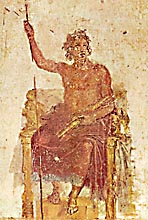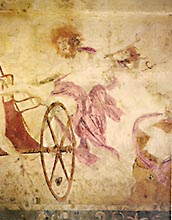It was generally pictures of myths that made the most
noise. But there was also some 'historical painting', for
example 'The Battle of Mantinea' by Euphranor -
also a distinguished sculptor - and 'The Battle of the
Greeks and Persians', attributed to Aristides son
of Nicomachus the painter. Apelles from Ephesus
seems to have been particularly fond of allegorical
subjects - he did a painting with the personifications
Scandalmongering, Spite, Ignorance, Graft, and Truth.
Apelles is also credited with great virtuosity in trompe-l'oeil
painting. But what he was most famous of all for, was his
precise and delicate linework. Pliny records an anecdote
about a competition between him and Protogenes.
Apelles won by drawing a line so fine that his opponent
gave up in despair. |
 |





